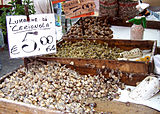
Clam is a common name for several kinds of bivalve molluscs. The word is often applied only to those that are edible and live as infauna, spending most of their lives halfway buried in the sand of the seafloor or riverbeds. Clams have two shells of equal size connected by two adductor muscles and have a powerful burrowing foot. They live in both freshwater and marine environments; in salt water they prefer to burrow down into the mud and the turbidity of the water required varies with species and location; the greatest diversity of these is in North America.

Spencer Spit State Park is a public recreation area ran under the Washington State Parks. It covers one hundred and thirty-eight acres (56 ha) on the eastern shore of Lopez Island in San Juan County, Washington. It overlooks the Strait of Juan de Fuca. The state park features two sand spits that enclose a salt chuck lagoon that provides a migratory stop for waterfowl, including Bonaparte's gulls. Other local fauna include great blue herons and kingfishers.

The Pacific razor clam, Siliqua patula, is a species of large marine bivalve mollusc in the family Pharidae.

Carcinus maenas is a common littoral crab. It is known by different names around the world. In the British Isles, it is generally referred to as the shore crab, or green shore crab. In North America and South Africa, it bears the name green crab or European green crab. In Australia and New Zealand, it is referred to as either the European green crab or European shore crab.
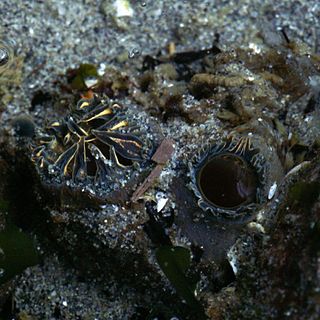
Tresus capax is a species of saltwater clam, marine bivalve mollusk, common name the fat gaper, in the family Mactridae. It also shares the common name horse clam with Tresus nuttallii a species which is similar in morphology and lifestyle. Both species are somewhat similar to the geoduck, though smaller, with shells up to eight inches long (20 cm), weight to 3–4 lb (1.4–1.8 kg).
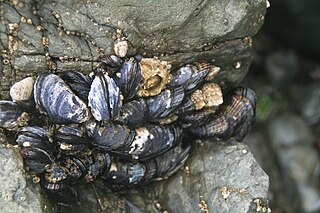
The California mussel is a large edible mussel, a marine bivalve mollusk in the family Mytilidae.
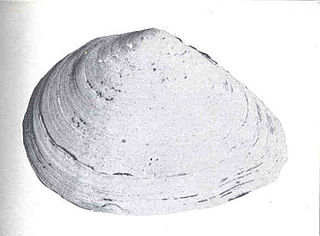
Macoma nasuta, commonly known as the bent-nosed clam, is a species of bivalve found along the Pacific Ocean coast of North America. It is about 6 cm (2.4 in) long. It is often found buried in sands of 10–20 cm (3.9–7.9 in) in depth. This rounded clam has no radial ribs. Archaeological data supports the use of this species by Native Americans such as the Chumash peoples of central California.

Venerupis philippinarum is an edible species of saltwater clam in the family Veneridae, the Venus clams.
Pinnixa faba, known as the pea crab, mantle pea crab or large pea crab, is a pea crab which lives harmlessly within a large edible clam. This species is a symbiont of Tresus capax and Tresus nuttallii in its mature stage.

Leukoma is a genus of saltwater clams, marine bivalve molluscs in the family Veneridae, the Venus clams. This genus of bivalves has been exploited by humans since prehistory; for example, the Chumash peoples of California harvested this genus from Morro Bay in approximately 1000 AD.
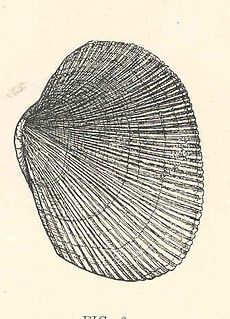
Leukoma staminea, commonly known as the Pacific littleneck clam, the littleneck clam, the rock cockle, the hardshell clam, the Tomales Bay cockle, the rock clam or the ribbed carpet shell, is a species of bivalve mollusc in the family Veneridae. This species of mollusc was exploited by early humans in North America; for example, the Chumash peoples of Central California harvested these clams in Morro Bay approximately 1,000 years ago, and the distinctive shells form middens near their settlements.
Saxidomus, common name the "Washington clams", is a genus of large edible saltwater clams, marine bivalve mollusks in the family Veneridae, the Venus clams.
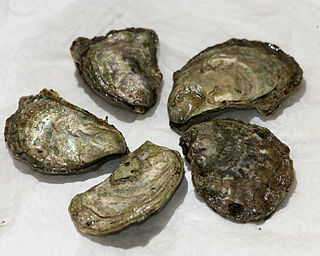
Ostrea lurida, common name the Olympia oyster, after Olympia, Washington in the Puget Sound area, is a species of edible oyster, a marine bivalve mollusk in the family Ostreidae. This species occurs on the northern Pacific coast of North America. Over the years the role of this edible species of oyster has been partly displaced by the cultivation of non-native edible oyster species.
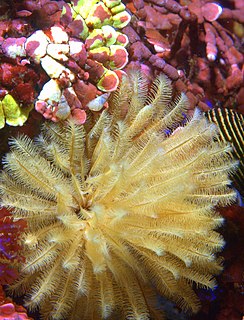
Carmel Bay State Marine Conservation Area (SMCA) is a marine protected area in Carmel Bay. Carmel Bay is adjacent to the city of Carmel-by-the-Sea and is near Monterey, on California’s central coast. The marine protected area covers 2.12 square miles. Recreational fishing of finfish and limited commercial taking of kelp is permitted within the SMCA.
Donax gouldii, common name the bean clam, is a species of small saltwater clam, a marine bivalve mollusk in the family Donacidae.

The Mediterranean mussel is a species of bivalve, a marine mollusc in the family Mytilidae. It is an invasive species in many parts of the world, and also an object of aquaculture.

Tresus nuttallii, common name the Pacific gaper, is a species of saltwater clam, a marine bivalve mollusk in the family Mactridae. It also shares the common name horse clam with Tresus capax, a species which is similar in morphology and lifestyle. Both species are somewhat similar to the Geoduck, though smaller, with shells up to eight inches long (20 cm), weight to 3–4 lb (1.4–1.8 kg).

Saxidomus gigantea is a large, edible saltwater clam, a marine bivalve mollusk in the family Veneridae, the venus clams. It can be found along the western coast of North America, ranging from the Aleutian Islands to San Francisco Bay. Common names for this clam include butter clam, Washington clam, smooth Washington clam and money shell.

Nuttallia obscurata, the purple mahogany clam, dark mahogany clam, varnish clam or savory clam, is a species of saltwater clam, a marine bivalve mollusk in the family Psammobiidae. It was first described to science by Lovell Augustus Reeve, a British conchologist, in 1857.

















